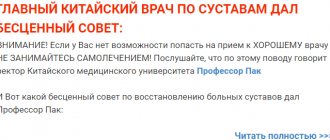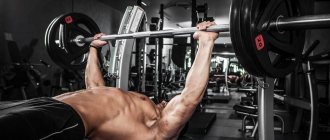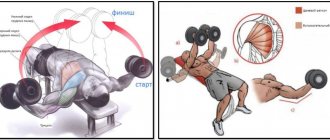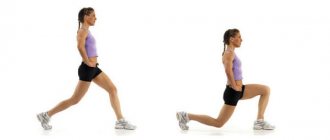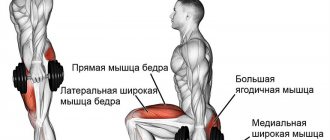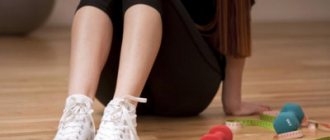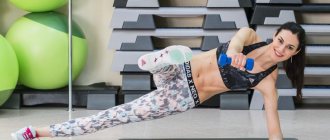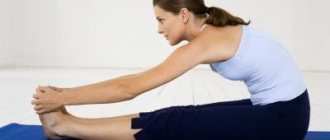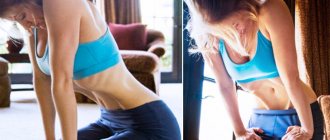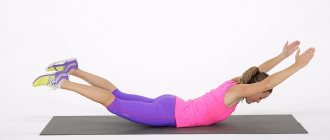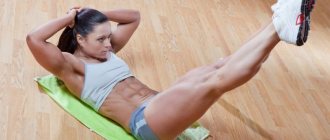- Take a gymnastic stick in your hands, place it behind your head on your shoulders, grab it with a grip wider than your shoulders - the wider the better, you can grab the very edges.
- Straighten up, bring your shoulder blades together, pushing your chest forward, bend your lower back slightly - let your spine take its natural position. Then the exercise will affect not only your muscles, but also your posture.
- Perform body turns to the right and left due to the efforts of the lateral abdominal muscles to the widest possible amplitude.
This is what it looks like:
Common mistakes
- Perform 15-20 repetitions of the exercise
. This will be of very little use. Since it is performed virtually without load, in order to properly warm up the muscles, you need to do 50 repetitions. One approach is enough. - Execution not to full amplitude
. Rotate your body as much as possible, stretching your muscles. There is no big load, so you don’t have to freeload. - Body tilt forward
. At the same time, the role of the oblique abdominal muscles in the movement is noticeably reduced; you may not warm them up enough. And if you want the most out of your workout, you can’t neglect warming up! - Rotate with your head
. You are not training the vestibular apparatus, but the core muscles, so the torso should move, not the head. If you turn it back and forth, severe dizziness and even nausea may occur, and coordination of movements will be impaired. And how are you going to continue to perform complex exercises, having reached such an inactive state already during the warm-up?
As we have already said, this is a warm-up exercise; it is not recommended to do it with weights. Don't expect that spinning will give you a slimmer waist. By pumping up the oblique muscles you can only expand it, but a gymnastic stick will not pump them up, and doing the exercise with weight is too dangerous. You can warm up with it before your abdominal workout, especially if you are going to do dumbbell side bends or lateral hyperextensions.
It is also good for warming up on leg day.
. If you are going to pull and squat, your obliques will be subject to a significant load, because they take part in heavy compound exercises as stabilizers of the body position. In addition, doing abdominal exercises before training your legs and thighs is generally a good practice, since this is where most of the vessels supplying blood to the legs pass through.
Due to the fact that the exercise is a warm-up, the optimal time to perform it is within 2-3 minutes. During this time, you will have time to do about a hundred repetitions in each direction. For untrained people, this can also be difficult - then the time is reduced to a minute and a half.
Who can benefit from this exercise?
Firstly, for experienced athletes who lift serious weights in basic exercises. Conventional joint gymnastics, performed before approaches, affects the oblique muscles little, and many of them perform warm-up approaches with such weights that seem prohibitive to nearby gym visitors. The weaker oblique muscles also do not like this situation; it is better to warm them up additionally.
Secondly, for beginners who are absolutely unathletic and have problems with excess weight. If a person has never trained, he needs to somehow tone his whole body. He is unlikely to be able to do lateral hyperextensions; for bending to the side with a dumbbell with a good working amplitude, sometimes there is not enough flexibility or fat deposits get in the way.
img src=»https://ifeelstrong.ru/wp-content/uploads/2014/10/49.jpg» alt=»» width=»300″ height=»232″ class=»alignright size-full wp-image -3959″ />But anyone can do three to four dozen body turns to the side. This number will gradually increase. Doing even such a simple exercise is better than doing nothing at all, especially since it will prepare the body to perform more complex ones. Then the exercise is not included in the warm-up, but in the main training program. There is no need to be ashamed of this - everyone starts somewhere, the main thing is to start.
The advantage of this exercise is that it can also be done at home.
. If you don’t have a gymnastic stick, you can use any long stick, a pipe from a vacuum cleaner, a mop, even a shovel, a rake or other agricultural equipment for physical education needs. You just need to be a little more careful in this case and make sure you don't hurt anyone.
Add these exercises to your workouts and become the owner of abs of steel.
Six or eight-pack abs are the cherished dream of many men, but not everyone knows how to achieve this cherished ideal. You can achieve abs of steel not only with endless crunches; there are many other equally effective exercises; By the way, too many twists can negatively affect the lower back. It's time to expand your arsenal of dream abs exercises.
↑ Possible influences of traditions
↑ (a) Traditional Tibetan “trul-hor” yantra yoga
Chogal Namhai Norbu
, one of the great masters of Dzogchen and Tantra, was born in Tibet in 1938.
His book Yantra Yoga: Tibetan Yoga of Movement
was published by Snow Lion Publishing House.
"Trul-hor" means "magic wheel"
, says Alejandro Chaul-Reich, a faculty member at the Ligmincha Institute and an assistant professor at the University of Texas Medical School. He says:
“The characteristic trul-hor movements arose as a result of the deep meditation practice of Tibetan yoga adherents. Traditionally practiced in remote Himalayan caves and monasteries, trul-hor movements are now accessible to serious Western students. They are a powerful tool for clearing, balancing and harmonizing the subtle aspects of your energetic dimension.”
Ryan Parker
specialist in
the Five Tibetan Rituals
, currently conducting research comparing the Five Rituals and the Trul-Khor. According to Peter Kelder in The Eye of Revelation, the rituals, like the trul-khor, date back about 2,500 years.
In his latest Comparative Table he states:
“The Buddhist trul-hor suggests the existence of energy centers rotating clockwise. Thrul-chorus is sometimes called a stimulus for the rotation of energy centers. Moreover, they begin to rotate in unison. Although this rotation can be caused in many ways, the rotation of the body is associated in a special way with the stimulation of the centers. Clockwise rotation is considered beneficial and is the suggested direction of rotation in the Buddhist 'trul-hor'."
↑ (b) Pradakshina
Throughout history, Tibet and India exchanged ancient knowledge, and it is possible - but not proven - that the First Ritual may have been influenced by the practice of Pradakshina.
In Hinduism Pradakshina
means the act of worship - walking clockwise around a holy place, temple, shrine. Dakshina means right, so you go to the left, with the spiritual object always on your right.
During Pradakshina, you walk clockwise around a temple, shrine, person, mountain, place or even yourself. Hindu temples even have special passages so that people can perform these movements around them in a clockwise direction.
The purpose of such circular movements is to focus or purify oneself, or to honor the object of worship.
Circling is so common that it is found in the cultures of the Greeks, Romans, Druids and Hindus. This is usually associated with a sacrifice or purification process. The interesting thing is that for all these cultures the direction of movement is always the same - clockwise!
The most effective abdominal exercises
It doesn't matter if you choose one exercise and build up your endurance or do five exercises at a time, these workouts are what you need to achieve your goal. Good luck!
Exercise "Polisher" with a barbell
Lie on your back, hold the barbell with outstretched arms at chest level. Without bending, lift your legs up. Lower your legs to the right, without touching the floor. Return to starting position and repeat on the left side.
Advice:
When your legs are lowered as close to the floor as possible, stay in this position for a couple of seconds. This will not only allow you to work your oblique muscles more effectively, but will also strengthen your core muscles, which in this position actively tense to maintain balance.
Hang 5 kilogram weights on the barbell. Grasp the barbell with an overhand grip, with your hands shoulder-width apart. Stand with your shoulders directly above the barbell and slowly roll the barbell away from you, then back to the starting position.
Advice:
The further you move the bar, the heavier it gets. Don't try to jump over your head and make sure your hips don't sag. One short repetition with correct posture is much more effective than holding the barbell as far back as possible with a hunched back.
Rotations of the body with the pull of the upper block (“Lumberjack”)
Stand a short distance to the side of the machine, feet shoulder-width apart, and grab the cable handle with both hands. Without bending your arms, pull the cable down towards the opposite knee, rotating your body as you do so. Bend your knees slightly and lean on your far leg. Slowly return to the starting position.
Advice:
Make sure that the cable does not “pull” you into the starting position, otherwise the effectiveness of the exercise will be halved. Return to the starting position slowly and with resistance. As you move backwards, slowly count to three.
Rotations of the body on the block
Grasp the cable handle with both hands so that your left arm is fully extended and crosses your body. Moving only your arms, pull the cable in the opposite direction until your right arm is completely straight. Return to the starting position and repeat the exercise.
Advice:
Fix the position of your arms and shoulders, suppress the desire to tense these muscles to help yourself. The better you are able to isolate your core, the faster you'll be able to boast six-pack abs.
dragon flag
Lie on your back, grab the bench above your head with your hands. Bend your knees and push your legs up towards the ceiling, thus lifting your back off the bench. Slowly lower your legs and return to the starting position, then repeat.
Advice:
Although this makes the exercise easier, do not swing your legs at the top. Instead, slowly stretch your legs to a crunch before pushing them upward.
Leg raises while lying on a bench
Lie on a bench, on your back with your legs hanging over the edge. Hold the edge of the bench with your hands to maintain balance. Keep your legs as straight as possible. As you exhale, raise your legs perpendicular to the floor. Then slowly return to the starting position.
Advice:
Press your lower back against the bench - this will not only allow you to specifically work on your abdominal muscles, but will also protect your spine from injury.
Throwing a medicine ball on the floor
Stand with your legs slightly bent, holding a medicine ball in straight arms above your head. Lean forward slightly and, using your core muscles, hit the ball as hard as you can on the floor about 30 centimeters in front of you. Let your hands follow the ball to avoid falling forward. Catch the ball and repeat the exercise.
Advice:
Make sure to perform this exercise as an abdominal exercise and not a shoulder exercise. Focus on curling your abs as you throw the ball to the floor. You will be surprised how much stronger you will become. The ball will bounce so high that you will have to avoid rooms with low ceilings.
V-crunch with medicine ball
Lie on your back, holding the ball above your head. Stretch your arms and legs, raise your palms and feet slightly above the floor. At the same time, lift your torso and legs up. Try to touch the medicine ball to your feet. Then slowly lower yourself back to the floor.
Advice:
Don't let the weight of the ball pull you back to the floor. Make sure you have good technique and keep your shoulders off the floor. This way, the abdominal muscles will work throughout the entire exercise.
Leg and body raises
Lie on your side, put your right leg on your left. Place your right hand behind your head, move your elbow to the side, and place your left hand in front of you for balance. Perform a twist, while trying to touch your right elbow with your right foot. Do the required number of repetitions on your left side, then on your right.
Advice:
If you're new to this exercise, you'll be more likely to feel tension in your hip flexors than in your obliques. Stretch after each set to loosen the tendons and increase the number of repetitions.
Side crunches
Lie on your back, bend your knees, and place your feet on the floor. Place your right hand behind your head, move your elbow to the side, place your left hand, palm down, perpendicular to your body. Tighten your abs, lift your shoulders off the floor, and reach your right elbow toward your left knee. Slowly lower yourself to the starting position. First, perform the required number of repetitions on one side and only then move to the other.
Advice:
Perform this exercise at the end of every abdominal workout. This exercise is best for creating abs of steel.
Plank with two-point support
Stand in the classic plank position: legs and arms are straight, shoulders are above the palms, the abdominal muscles are tense, the whole body is in a straight line. Tighten your abs and, resisting the urge to lift your hips, raise your right arm and left leg parallel to the floor. Slowly return to the starting position and repeat on the opposite side.
Advice:
Raising two limbs turns a standard plank into a dynamic exercise for high-quality development of the abdominal muscles. If, of course, you follow the execution technique. If you have trouble maintaining your balance, lift one limb at a time.
Body Lifting
Get into a plank position, supporting yourself on your forearms, with your hands shoulder-width apart. Place your palms on the floor and stretch your body upward, while your torso remains straight. Slowly lower to the starting position and repeat.
Advice:
Is your goal not only pumped up abs, but also big and strong shoulders and arms? This exercise combines upper body work using a plank - 3 sets of 20 reps from any plank.
Crab
Sit on the floor, hands behind your back, knees bent in front of you. Lift your hips up, supporting yourself only on your palms and feet. Start walking using both your arms and legs.
Advice:
Raising yourself just a couple of centimeters above the floor will only put stress on your shoulders. Keep your hips as high as possible. Try to walk about 25 meters and ignore the chuckles behind you.
Spider movement
Starting position: lying position. Lift one leg off the floor and pull it towards your elbow. Hold this position for a moment, then return to the starting position and repeat with the other leg.
Advice:
To add complexity to the exercise and work your obliques more effectively, after pulling your knee to your elbow, move your leg back a little, then pull your knee back to your elbow and only then return to the starting position.
Crunches with leg raises
Lie on your back, stretch your arms up above your head. Pull your knees to your chest and at the same time lift your back off the floor and, helping yourself with your hands, perform a twist. Return to the starting position and then repeat.
Advice:
Stretch your arms above you throughout the exercise. This will increase the range of motion, which has a positive effect on the work of the abdominal muscles.
Swing your legs
Lie on the floor, raise your heels 10-15 centimeters from the floor, while straining your core muscles. Alternately lift one leg and lower the other, as if you were swimming in a pool.
Advice:
Cross your legs left and right, not just up and down. Then your abs will work in different directions, also using the oblique abdominal muscles.
Hanging Leg Raise
Grasp the bar, making sure that while hanging, your feet do not touch the floor. Allow your straight legs to pull your pelvis slightly back. Tighten your abdominal muscles and raise your legs until they are perpendicular to your torso. Stay in this position for a short time, then slowly return to the starting position.
Advice:
Allow your legs to swing freely after each repetition. This will force you to tighten your abs more to avoid excessive swinging. If you hang around, you won't achieve success.
Crunches on the upper block “Prayer”
Kneel in front of the machine, holding the cable handles on either side of your neck. Without moving your hips, using only your abdominal muscles, try to reach your hips with your elbows. At the bottom point, hold for a few seconds and then return to the starting position.
Advice:
Don't be afraid of aggravation. This is one exercise that doesn't depend on your body weight and you don't have to do 20 reps to figure it out. Keep a steady pace and do not make sudden movements.
Raising the torso with a sandbag
Lie on your back, bend your knees, hold a sandbag (sports equipment - a bag of sand) on your arms outstretched in front of you. Tighten your abs and lift your torso up so that your upper body forms a V with your hips. Slowly return to the starting position.
Advice:
To make the exercise easier, rest your feet on something. In another situation we would call this cheating, but you're doing the exercise with extra weight, so it's forgivable.
Russian crunches with weight
Sit on the floor with your legs straight in front of you and hold a sandbag with your arms outstretched in front of you. Quickly turn the body left and right, while moving the sandbag in different directions.
Advice:
Avoid moving your shoulders and glutes to isolate your abs as much as possible. This will force your core muscles to work even harder to absorb the impulse from shifting the bag.
Initial position
The exercise can be performed either standing or sitting on a horizontal bench. Place your feet shoulder-width apart and bend your knees slightly. If you choose the sitting option, then sit on a bench. Further provisions are identical. There is a natural arch in the back and fixation until the end of the exercise. The stomach needs to be pulled in and tense. Place the bar or bodybar on the top of the trapezoid; if it is painful or uncomfortable, then lower it lower - onto the rear delts and trapezius. Grasp the edges of the bar or bodybar with your hands, elbows slightly bent and pointing down. The neck is straight and the gaze is directed straight.
How to do it right
- Stretching should be done when the body is already warmed up (running, exercise bike, jump rope, etc.)
- Muscle stretching exercises eliminate sudden movements. Therefore, under no circumstances should you stretch with sudden jerks.
- All stretching movements should be smooth.
- The load needs to be adjusted. Muscle stretching should not result in constant pain. At the first signs of severe muscle tension, the load should be reduced.
- Should not be delayed during training. It should be smooth and look like this: starting position - inhale, stretch - exhale.
- Remember, doing exercises incorrectly can lead to serious injuries for life.

